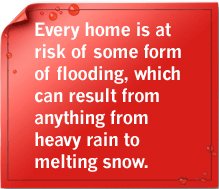
Until the spring thaw, the hard, frozen earth prevents melting snow or rainfall from seeping into the ground. The resulting run-off can overfill streams, rivers and lakes. Add spring storms, and you have a recipe for serious seasonal floods.
Preventing Snow Melt Problems
Snow can hold a lot of water. Each cubic foot of drifted, piled or compacted snow may contain gallons of water. If you take action now, you can prevent that snow from becoming a flooding problem.
Make sure downspouts carry water several feet from your house to a well-drained area. About 2,500 gallons of water will come from a 1,000 square foot roof with one foot of snow depth across the roof. This much water may cause problems if it’s allowed to drain next to your house.
Move snow on the ground away from the house. Water from the snow may cause a wet basement if allowed to run down along the basement wall. If the ground is sloped 1 inch per foot near the house, moving the snow just 3 to 5 feet from the house will reduce problems.
If you have a sump pump, examine and clean it. Test your sump pump by pouring water into the pit. Make sure the discharge hose carries the water several feet away from the house to a well-drained area. Also make sure that the pipe is on sloped ground so it drains to prevent it from freezing.
Remove snow from around rural yards to minimize soft, wet soil conditions. Remember that a 20-foot diameter, 10-foot high pile of snow contains about 2,600 gallons of water. Move the snow to well-drained areas.
Mississippi River Flooding
Residents along the Mississippi River are no strangers to overflows and flooding during the spring thaw and rains.
Since the early 18th century, settlers have built levees and floodwalls along the 2,000-mile waterway to try and control it. However, in years with record-breaking rainfall (such as 1927 and 1993), it has become impossible to "tame" the river.
The 1993 floods caused such extensive damages that 563 counties were declared disaster areas, including the entire state of Iowa. The deluge swept across the Midwest, creating an ocean of floodwaters that inundated nine states and submerged entire communities. Nearly 50 people were killed and 55,000 homes were damaged or destroyed in what became one of the most widespread natural disasters in U.S. history.




500 C Street SW, Washington, D.C. 20472
Disaster Assistance: (800) 621-FEMA, TTY (800) 462-7585
U.S. Department of Homeland Security
FEMA Home | Contact FEMA |
Privacy Policy | Important Notices |
FOIA | USA.gov | DHS
